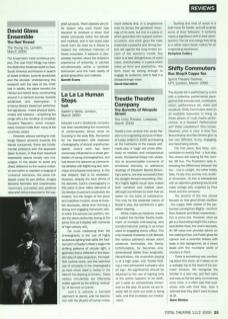Edouard Lock's Quebecois company has been accelerating the movement of contemporary dance since its founding in the early 80s. Renowned for his fascination with explosive choreography of almost superhuman speed, Lock's work has been immensely influential on a whole generation of young choreographers, and has shown his dancers as phenomenal athletes with frightening skill, technique and physical endurance. In this last respect, Salt is no exception. However, despite the best efforts of his dancers, Lock's choreography in this piece is poor. Many elements of his familiar movement vocabulary are evident, but the length of the piece and repetitive musical, visual and spatial structures, rather than forming a strong and engaging framework within which the dancers can perform, render the piece profoundly boring at the same time as it dazzles with moments of high-velocity skill.
Far more interesting than the choreography is the use of highly sculptural lighting that splits the football pitch of Sadler's Wells' stage into shifting patterns of circular light, a geometry that is reflected in two beautiful sets of video projection, the repetitive cyclical score, and the extensive use of circularity in the choreography (a word which itself is rooted in the idea of the drawing of circles). These various circularities are effectively pulled against by the striking verticality of dancers on pointe.
Lock's is certainly a formalist approach to dance, and his fascination with the physics of human movement reflects this. In a programme note he denies the gendered meanings of his work, but this is a piece in which grounded men support women on pointe, and which gives the male ensemble a powerful and driving section set against the long-limbed lyricism of the women's motifs: this claim is at best disingenuous, at worst naive. Unfortunately, in a piece which relies on form and abstraction, the form must be strong enough to engage its audience, and in Salt it is disappointingly weak.

